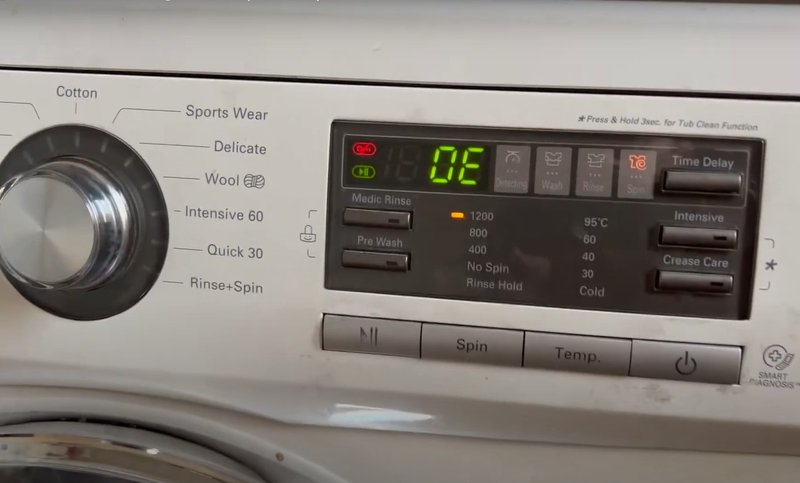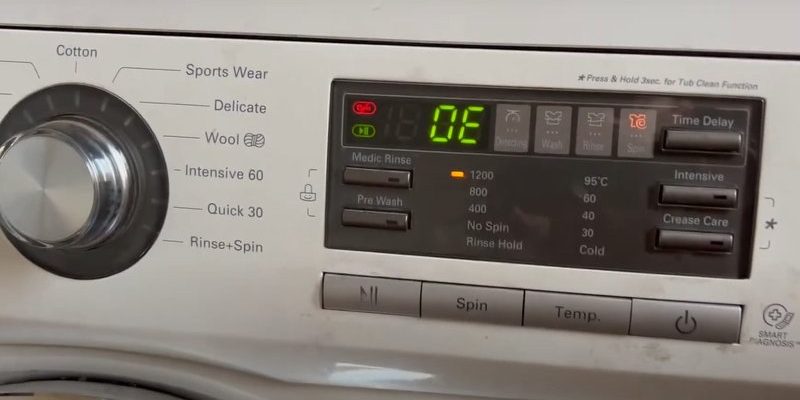
You might be wondering why your trusty washer suddenly refuses to cooperate. The OE error is not just a random glitch. It’s often linked to a few common issues—like a kinked drain hose, a dirty filter, or a malfunctioning drain pump. Think of it as your washing machine waving a little red flag, insisting on a bit of tender loving care. The good news is, with some easy maintenance steps and a few preventative measures, you can minimize the chances of this error code showing up in the future. Let’s dive into how you can keep your washing machine happy and working smoothly.
Understanding the Causes of the OE Error Code
To tackle any problem, it’s crucial to start with understanding why it happens in the first place. The OE error in LG washing machines is primarily related to drainage issues. Imagine trying to pour a bucket of water into a funnel, only to find out that the bottom is blocked. Just like that blockage prevents the water from flowing smoothly, any obstruction in the washing machine can trigger the OE error.
The most common culprit is a clogged drain filter. Over time, every day residues, lint, and even small clothing items can accumulate in the filter, much like how leaves block a rainwater gutter. If these aren’t cleaned out regularly, they block water from draining, prompting the machine to halt and flash that annoying error code. Another frequent issue is a kinked or improperly positioned drain hose. Sometimes, during installation or due to movement, the drain hose might get pinched or twisted, restricting water flow.
Additionally, the drain pump itself might face issues. If the drain pump, which works like the heart of your washing machine’s drainage system, is clogged or malfunctioning, it can’t pump water out effectively. This could be due to debris or mechanical failure. Knowing these causes helps in diagnosing the problem quickly and preventing future occurrences. So, what can you do about it? Read on to find out!
Regular Maintenance: Keeping the Drain System Clear
Now that you know what might be causing the OE error, let’s talk about regular maintenance—a simple and effective way to prevent it. Think of this as giving your washing machine a little spa treatment. First up, is cleaning the drain filter. This filter is like a net that catches unwanted debris. Every month or so, check the filter by opening the access panel, which is usually located at the bottom front of the machine. Carefully unscrew the filter cap, have a towel ready for any water that comes out, and remove any trapped dirt or fabric. Trust me; this little task can do wonders.
Next, let’s chat about the drain hose. Make sure it’s properly installed and free from kinks. If you notice any bends or pinches, straighten them out to ensure a smooth flow. Also, be certain that the end of the drain hose is at the correct height (usually 24 to 40 inches from the floor) to prevent backflow, which can mimic the same problems as a clog.
Finally, consider the drain pump’s wellbeing. While the pump doesn’t need frequent cleaning, being aware of its condition is wise. Listen for strange noises during the drain cycle, as these might indicate a blockage or wear. If you suspect pump issues, it might be time to consult a professional for a thorough check-up or cleaning. Consistent attention to these components will keep your machine running smoothly and OE error-free.
Preventative Tips: Keeping OE Error at Bay
Prevention, as they say, is better than cure. When it comes to your washing machine, forming a few good habits can prevent the OE error from appearing. First, be mindful of what you’re washing. Avoid washing excessively dirty or gritty items that might shed a lot of debris. Consider giving them a good shake or rinse before they go into the machine. This way, you minimize the amount of dirt entering the system from the get-go.
Are you using the right amount of detergent? It sounds simple, but using too much detergent can create excess suds, which could lead to drainage problems. Think of it like trying to rinse out a soapy sponge—too much soap, and it just keeps foaming. Always follow the detergent instructions to avoid this issue.
Finally, having a glance at your machine’s load is vital. Don’t overload it. Overloading can stress both the drum and the drainage system, leading to inefficient washing and potential blockages. If you’re unsure about the weight, remember this rule of thumb: leave about a hand’s width of space at the top of the drum. This gives your clothes enough room to move around for effective cleaning while also ensuring proper drainage.
What to Do When the OE Error Appears
Even with the best efforts, there might be times when the OE error decides to make an appearance. Don’t panic! Consider it an opportunity to troubleshoot. Start by pausing your machine and checking the drain hose for any obstructions or kinks. It’s like checking the garden hose when the water flow stops suddenly. Adjust or straighten the hose as needed.
If the hose seems fine, move on to the drain filter. Open it, as we discussed earlier, and clean out any debris or lint. Sometimes, that’s all it takes! Once you’ve done this, give the machine another go. If the error persists, it might be time to consider a deeper look at the drain pump or call in a professional for assistance. It’s like calling an expert plumber when the sink still won’t drain.
Moreover, take note of any unusual noises or behaviors coming from your machine. These can be valuable clues that might help a technician quickly diagnose the issue. Sharing these observations can speed up repairs and get your laundry routine back on track.
As a next step, keep a log of any recurrent issues with your machine. This can help identify patterns or problems that might warrant an expert eye. Staying proactive with maintenance and being mindful of your washing habits can go a long way in keeping the OE error at bay and ensuring your laundry days remain smooth and stress-free.
